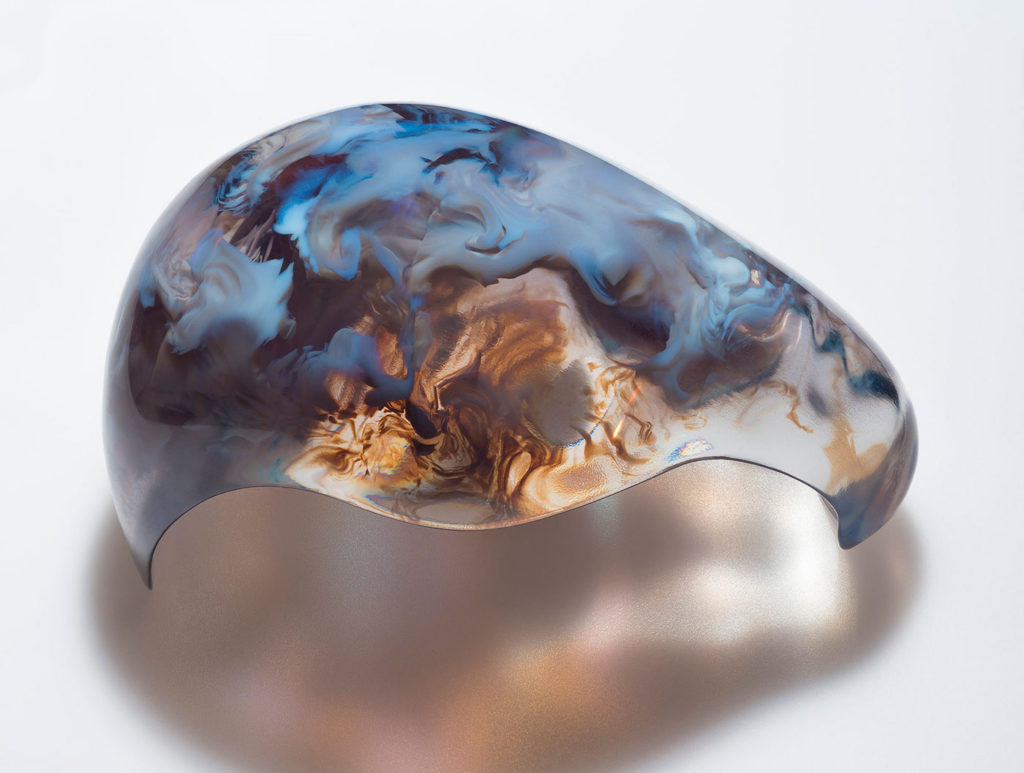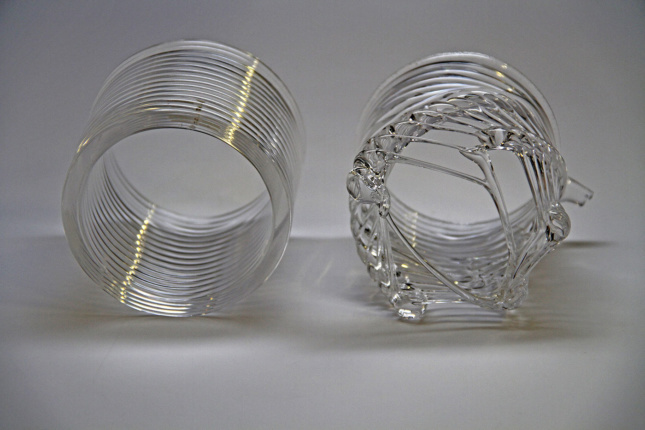A pioneer in materials, objects, and construction, Neri Oxman is showing work from her 20-year career as an architect, designer, and inventor at the Neri Oxman: Material Ecology exhibition currently on view until May 20 at New York City’s Museum of Modern Art (MoMA).
Curated by Paola Antonelli with help from curatorial assistant Anna Burckhardt, Oxman’s work on display explores the intersection of the science of materials, digital fabrication, and organic design in pieces both extruded from and infused with the wisdom of nature. This is Oxman’s seventh exhibition at MoMA, and Material Ecology is a magnifying glass for the vibrant microstructures that give shape to the world.
“My team and I stand in the crossroads, challenging some of the processes that designers face at the intersection of biology and technology, nature and culture,” Oxman said during a media preview of the show on February 20. “There will come a moment where we will find material singularity [a state in which we cannot differentiate between what is man-made and what is grown]—was this made, was this built, or was it grown? And does it matter?”
As a professor of media arts and sciences at the MIT Media Lab and founder and director of The Mediated Matter Group, Oxman observes naturally occurring structures, such as birch tree bark and crustacean shells, and routines, such as silkworm behavior, and presses them forward toward innovative building materials.
“We envision these different objects that are processes and materials as tools for the future,” Antonelli said. “As tools for architects, designers, artists to make in a different way together with nature.”
The exhibition includes demonstrations of what these processes could ultimately lead to one day, with tables arranged to resemble Oxman’s lab, videos displaying the projects’ progressions, and the artifacts themselves. The works are categorized into “Infusions” and “Extrusions”:
Infusions
Totems is a series of 3D-printed photopolymer resin infused in melanin. The three 5 7/8” x 5 7/8” x 19 5/16” blocks are set within black columns, suggesting a future as a compressive building material. They stand in front of a rendering of an illuminated structure in Cape Town, South Africa, that employs Totems as walls.
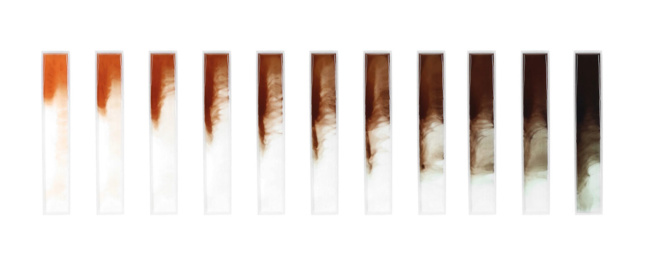
A collection of contemporary interpretations of ritualistic death masks made from photopolymer, Vespers are infused with natural minerals and bacteria. The 15 futuristic masks range from the size of a human head to nearly twice that and were created with spatial mapping algorithms. Some seem to be almost coral-like metallic kaleidoscopes, while others resemble opals with frozen whisps of color.
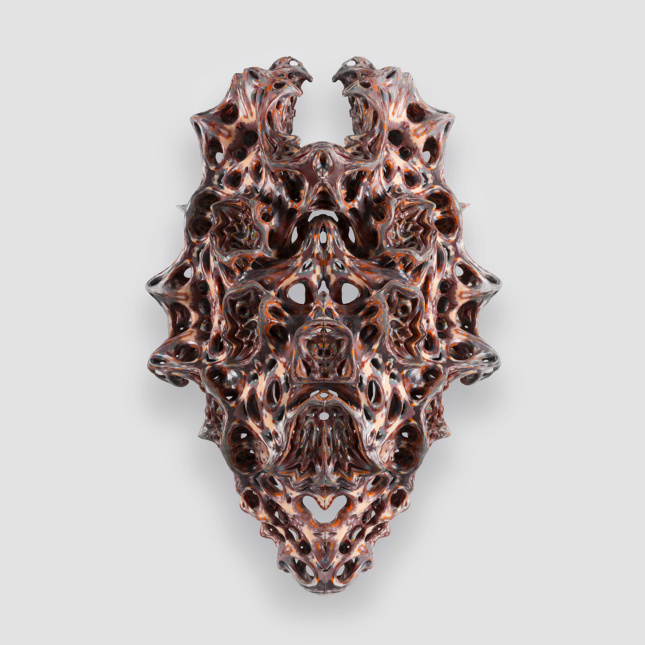
Imaginary Beings are multicolored photopolymer interpretations of body armor inspired by Luis Borges’s Libro de los seres imaginarios (Book of Imaginary Beings, 1967), which described 120 mythical animals from folklore. The creations range from protective helmets to breastplates resembling crystalline dragonfly wings.
Extrusions
Glass, pseudo-cylindrical printed structures, were created with The Mediated Matter Group’s 2015 invention G3DP, or Glass 3D Printer. The exhibition includes smaller samples, roughly 8 inches in diameter as shown below, and larger columns of printed glass, reaching almost 10 feet high.
As the focal point of the exhibition, Silk Pavilion II is a suspended structure of water-soluble mesh stretched across an aluminum framework covered in silk spun by 17,532 silkworms. The twisted gossamer cylinder stretches almost 20 feet, nearly doubling the size of the Silk Pavilion I dome constructed at the MIT Media Lab in 2013. Through 3-inch-square studies (exhibited beneath the pavilion), Oxman and her team were able to pinpoint the geometrical situations in which silkworms spin flat sheets as opposed to three-dimensional cocoons, enabling the researchers to design a structure that could be spun by the silkworms themselves, rather than a machine that uses the silk. This discovery allowed for a fabrication process that works in harmony with nature rather than in dominance over it.
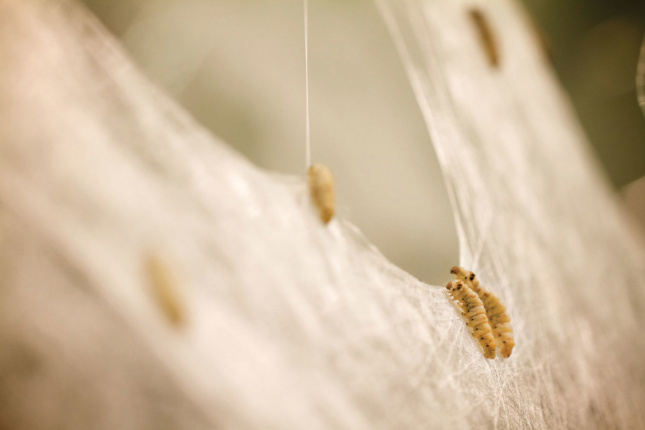
Aguahoja I is a collection of objects printed from biopolymers, including wood-pulp cellulose, apple pectin, calcium carbonate, acetic acid, vegetable glycerin, and chitosan. The installation stretches across the wall of the gallery and consists of a library of fabricated pieces designed to be compatible with nature. The water-based objects are designed to decay over time, serving as a temporary alternative to plastics.
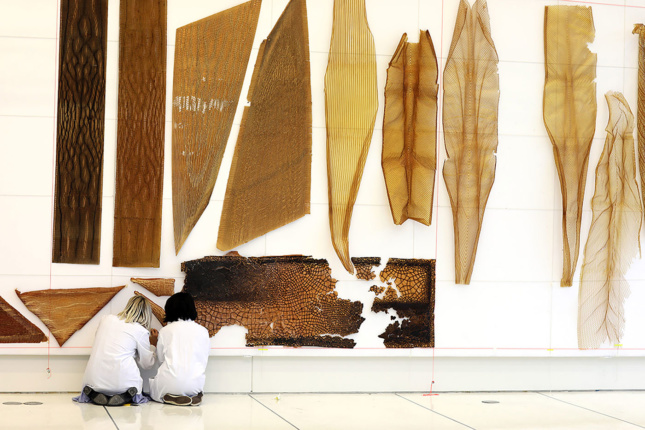
Oxman and her research team at the Mediated Matter Group operate through what they call the Krebs Cycle of Creativity, which is “a framework that considers the domains for art, science, engineering, and design as synergetic forms of thinking and making in which the input from one becomes the output of another,” as defined in the exhibition’s catalog, designed by Irma Boom.
“The input for science is information. Science converts information into knowledge. Engineering then takes knowledge and translates it to utility. Design then takes utility and places it in a cultural context,” Oxman explained. “Then art takes all things designed around us in the built environment and questions the perception of the world.”
Funded by Allianz, MoMA’s partner for design and innovation, Material Ecology embodies Oxman’s Krebs Cycle with artifacts that are more grown than made, through a process called templating. The researchers and designers at the Mediated Matter Group used environmental, geometrical, chemical, and genetic influences to manipulate materials.
“They are singular materials that differentiate their properties locally to accommodate for environmental and structural strengths,” Oxman said. “They are not made of parts. They are wholes that are bigger than the sum of their parts.”
